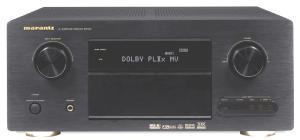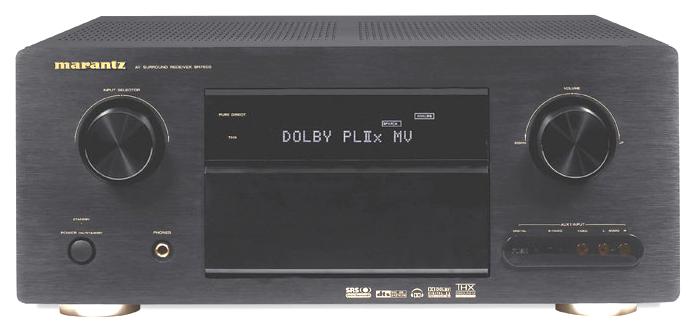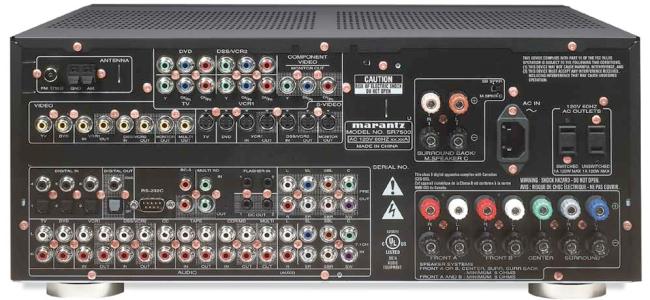Marantz SR7500 7.1 A/V Receiver

Specifications:
- Codecs: DD,
DD-EX, DPL-IIx, DTS, DTS-ES,
DTS Neo:6, DTS 96/24, THX Surround EX,
Dolby Headphone, SRS Circle Surround II
(THX Select Certified)
- Power: 105 Watts x 7
- DACs: 24/192 on All Channels
- MFR: 8 Hz - 100 kHz �
3 dB
- THD: 0.08%
- Zone 2 Available
- MRAC Auto-Calibration
- Dimensions: 6.75" H x 17.9" W x 18.25" D
- Weight: 32.6 Pounds
- MSRP: $1,099 USA
Marantz America, Inc.
Introduction
I still remember my first Marantz experience. I was in
high school, visiting a friend who lived in the nice part of town. His
father's stereo was a BIC turntable anchored to a Marantz receiver, and he was
playing Who's Next. I thought I knew every note of that album by heart, but
hearing it through the Marantz was something totally different. John
Entwistle's bass had an audible growl to it, Pete Townsend's guitar chords
jumped out into the room, and Keith Moon's pounding toms seemed to hover above
the mix. I didn't know a record album could sound like that.
30 years later, Marantz is still around, and still making high quality home
theater components. The SR7500, Marantz's least expensive THX-Select-Certified
Receiver at $1,099 MSRP, occupies the crowded space that is
sometimes referred to as �mid-fi.� Placing the SR7500 in my equipment rack, I
wondered if Marantz still had the magic touch.
Set-Up
The SR7500 is of the black monolith school of design, adorned with a center
display flanked by two large knobs on either side, for input and volume. A
large drop-down door under the display hides an impressive array of buttons
that allows you to operate the receiver's functions in case the remote control
falls into a black hole or between the couch cushions. Alas, the
horizontally-oriented gyro tuning wheel that I found so cool as a teenager
is now found only in Marantz's
flagship receiver (SR9600).
The standby button glows red when the unit is powered
down.
Connections on the back panel are a breeze, with six digital audio inputs
(three each of optical and coaxial), four high-bandwidth video component
inputs, seven-channel analog input (for DVD-A and SACD players), and seven
stereo analog audio input pairs.
The SR7500 sports high-end features such as two DC trigger
control jacks, an RS-232C port for operating an external controller or future
software updates, and automatic speaker set-up with a supplied microphone (Marantz
calls this M.R.A.C., or Marantz Room Acoustic Calibration).
 The
fully back-lit remote control has several user friendly features, including
individual source buttons for one-touch switching (on the other hand,
switching sources on the front of the receiver involve twirling the large
input knob until you land at the proper source, which annoyed my wife to no
end). The five function buttons flanking the large LED display occupying the
upper third of the remote don't always line up neatly with the text, causing
a few mixed messages and erroneous commands. Like most remote controls in its
price range, the SR7500's remote can be used as a universal remote (controlling 12
types of components), and can be programmed with macros for one-touch operation.
The
fully back-lit remote control has several user friendly features, including
individual source buttons for one-touch switching (on the other hand,
switching sources on the front of the receiver involve twirling the large
input knob until you land at the proper source, which annoyed my wife to no
end). The five function buttons flanking the large LED display occupying the
upper third of the remote don't always line up neatly with the text, causing
a few mixed messages and erroneous commands. Like most remote controls in its
price range, the SR7500's remote can be used as a universal remote (controlling 12
types of components), and can be programmed with macros for one-touch operation.
I was curious to try out the M.R.A.C. automatic speaker set-up, which is supposed to automatically detect and set
speaker distance, size, and levels. Unfortunately, the MRAC simply would not
function on the review unit. No matter what I tried, I kept getting an
�Ambient Noise Error� message, and after turning off every appliance in the
house, unplugging the unit and finally resetting it, decided that it was
defective (an extra demerit because Marantz technical support never responded
to my e-mail inquiry). I am going to give Marantz the benefit of the doubt
here, and just assume that this auto set-up works pretty much like the
others we have seen in similarly priced receivers these days. It will
undoubtedly give you a calibration in the general area of acceptability, and
then you can fine tune it manually.
Of course, the SR7500 allows for
complete manual speaker set-up. Speaker size can be set
at Large or Small for the Front L/R, Center, Surround L/R, and Rear Surround
speakers (which you can set for either one or two rear surround speakers). The
subwoofer/LFE cut-off can be set at 80, 100, or 120 Hz, depending on the size of
your main speakers. You can set the subwoofer to operate with two-channel
audio sources, or bypass the subwoofer so that low frequencies are routed
solely through the two main speakers.
Speaker distances can be set in meters or feet, in precise increments (0.3
foot or 0.1
meter), and each speaker level adjustable between �15
and +10 dB in 1 dB intervals. The speaker levels apply universally to all
inputs, other than the 7.1 analog input, in which speaker levels can be set
independently. While the separate level controls for the 7.1 input were
useful, it would be nice to have independent level controls assignable for
each input (such as DVD, DSS, etc.), saving the occasional lunge for the
volume control when switching between inputs.

The SR7500 has a full complement of the latest processing modes, including THX
Surround EX, DD EX, Pro Logic IIx, DTS-ES, Dolby Headphone and SRS Circle
Surround. Activating the THX button automatically engages Re-Equalization,
Timbre Matching and Adaptive Decorrelation processing. Lip sync delay is
adjustable via the remote control in 10 ms steps up to 200 milliseconds,
although it cannot be set independently for each input. For audio purists, the
video circuitry can be turned off and all tone controls and bass management
features bypassed through the Pure Direct mode. Like many 7.1 channel
receivers, the SR7500 can be set for multi-room listening with the main system
operating in 5.1 mode.
The Marantz can be configured to automatically detect the decoding flag in
various broadcasts, and it flawlessly identified the appropriate processing
mode without audible delay. You can also manually set default processing modes
depending on your personal preferences. I set up the SR7500 in 7.1 channel
mode, with the crossover set at 80 Hz, and automatic decoding for native
processing modes. I used THX processing for most DVDs. Two-channel music
listening varied between Pure Direct, as well as with the subwoofer engaged,
and occasionally simulated 7.1 channel sound using Dolby Pro Logic IIx.
Click on Photo Above to See a Larger Version.
In Use
If you haven't figured out the first CD I played on the SR7500, then you
haven't been paying attention. Who's Next (digitally remastered) was as good
as the first time. The SR7500 provided excellent imaging and detail, from the
first ARP synthesizer notes of "Baba O'Riley" to the final harmonies of "Behind
Blue Eyes". Even better, the Marantz reproduced the music without obvious
coloration. Despite many hours of listening, I never found myself thinking in
terms like �bright� or �warm.�
Multi-channel music, which focused attention on the amplifier section of the
SR7500, was similarly impressive. Emerson, Lake & Palmer's "Lucky Man" (bonus
track on the Brain Salad Surgery DVD-A) is an excellent workout for all five
channels, with guitars and keyboards swirling around the listener. The SR7500
is rated at 105 watts per channel, and when I approached reference volume
(-5 dB), there was no noticeable compression or strain. Switching to movies, I
watched Monsters, Inc. and Finding Nemo for the umpteenth time (and they never
seem to get old, either!) The Marantz did yeoman's work, placing the listener in
the action, whether it was Sydney Harbour or Monstropolis. Dialogue was clear
and distinct, especially with the THX processing engaged.
Conclusions
Notwithstanding the problems I had with the auto set-up feature (M.R.A.C.), the Marantz SR7500, at $1,099 list price, offers the kind of sound quality
often found in higher priced receivers. If I were in the market, I would take
a long look at the SR7500, as well as Marantz's next-in-line receiver, the SR8500, which includes a laundry list of desirable features (toroidal
transformer, HDCD decoder, and DVI switching) for another $500. I'd call that
a bargain.
- Ross Jones -


